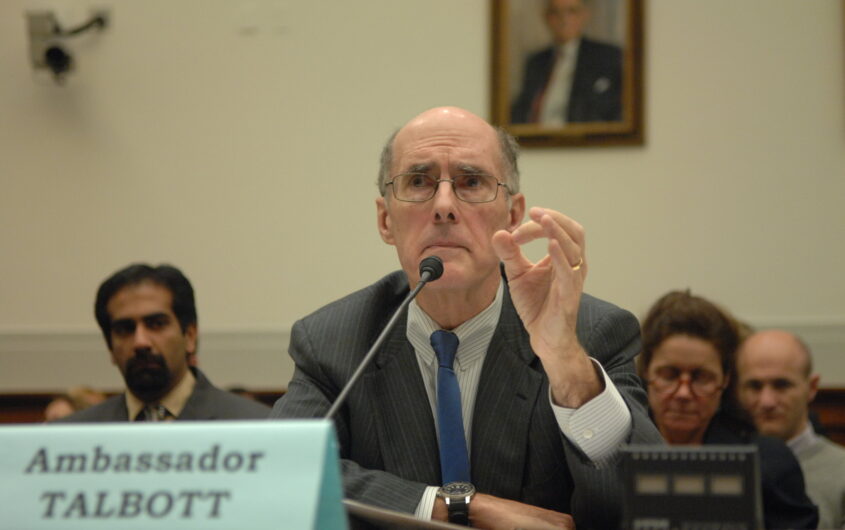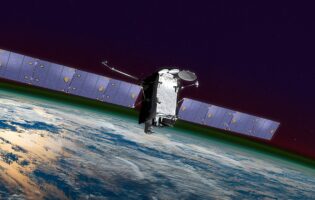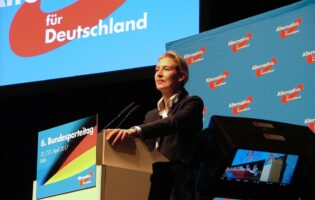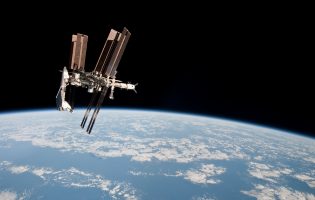
Brookings Institution via Flickr
Strobe Talbott and the Rise of the Liberal Post-Cold War Order

Stephan Kieninger
Historian
Stephan Kieninger holds a PhD in Modern History from Mannheim University and had previously been a Wilson Fellow at the Woodrow Wilson Center, a postdoc at Johns Hopkins SAIS, a fellow at the Berlin Center for Cold War Studies, and a Senior Researcher at the Federal German Archives.
He is the author of three books on U.S. foreign policy and European security in the Cold War and after: Securing Peace in Europe. Strobe Talbott, NATO, and Russia after the Cold War (Columbia University Press, 2025), The Diplomacy of Detente. Cooperative Security Policies from Helmut Schmidt to George Shultz (Routledge, 2018), Dynamic Détente: The United States and Europe, 1964–1975 (Rowman & Littlefield, 2016), and has received fellowships from the German Historical Institute, the Hoover Institution, and the German Academic Exchange Service.
Currently, we are witnessing enormous stress on the institutions established in the post-Cold War era. A new era of great power competition and a revival of authoritarianism threaten to undermine the norms that have underpinned the international system for three decades. These structures took shape during the presidency of Bill Clinton when the United States emerged as the world’s sole superpower, using its unprecedented opportunities to expand the liberal order on a global scale. Strobe Talbott was one of the senior advisers—first as Russia adviser and then for seven years as Deputy Secretary of State—who helped President Clinton pursue a liberal internationalist foreign policy based on the assumption that cooperation among nations was essential to security in an increasingly interconnected and globalized world. Their blueprint for U.S. leadership hinged on the adaption and expansion of the institutions that enhanced the prosperity and security of the West after the end of World War II, including the United Nations, NATO, the European Community, the International Monetary Fund, the World Bank, and the General Agreement on Trade and Tariffs.
“Uniquely in the history of Great Powers,” Talbott wrote in a 1998 article, “the United States defines its greatness not as an ability to dominate others but as an ability to work with others in the interest of the international community.” After the end of the Cold War, Talbott saw the necessity of integrating the newly emerging countries, and to this end he endorsed the establishment of new international organizations and treaties, such as the Asia-Pacific Economic Cooperation Forum, the North Atlantic Free Trade Agreement, the World Trade Organization, and the Kyoto Protocol on Climate Change. Talbott later recalled:
Clinton was diametrically opposed to Charles Krauthammer’s concept of the “unipolar moment,” which held that the United States had a several-decade window of opportunity to get its way unilaterally—unencumbered by the need for consensus-building and compromises—before the world became multipolar. Clinton just believed the opposite: what we had in the wake of the Cold War was a multipolar moment—and an opportunity to shape the world through active leadership by the institutions Clinton admired and Krauthammer disdained.[1]
As a bottom line, the Clinton administration was determined to pursue a policy of democratic enlargement, which would promote democracy, self-determination, and international law. “The successor to a doctrine of… containment must be a strategy of enlargement of the world’s free community of market democracies,” National Security Advisor Anthony Lake argued. Talbott, too, wanted the United States to be a force for good in the new era. He very much saw the United States as an indispensable nation. “If the United States leads, the world will be a safer place for Americans to live, work, travel, and trade,” Talbott thought.
Throughout his eight years in office, Talbott helped establish security architectures and communities in which a web of international institutions would provide stability to transcend purely national notions of security and statehood. Talbott thought that a lasting global peace necessitated post-national security policies and a turn away from the traditional concepts of geopolitics and the balance-of-power approaches of the past. Over the long term, he envisaged the world as a ‘global nation,’ moving beyond the traditional Westphalian definition of statehood and sovereignty. In a 1992 essay for TIME Magazine on “The Birth of a Global Nation,” Talbott wrote:
the best mechanism for democracy, whether at the level of the multinational state or that of the planet as a whole, is not an all-powerful Leviathan or centralized superstate, but a federation, a union of separate states that allocate certain powers to a central government while retaining many others for themselves.
When Talbott entered government, his views were tempered by his official experiences. After the end of the Cold War, newly emerging states hesitated to abandon their recently acquired sovereignty. The wars in the Balkans revealed that boundaries were often contested. At the same time, ethnic conflicts reaffirmed the importance of integration and international institutions to project stability over the long term. Talbott thought that European integration and the emergence of the European Union following the Maastricht Treaty in 1992 were role models in this endeavor. They provided a bulwark against retrogression and backsliding into old patterns of nationalism and geopolitics that had destroyed Europe twice in the twentieth century.
After the end of the Cold War, the EU’s deepening and opening were essential in bringing Europe toward a rules-based order and a system that had to include the countries that had suffered from Communism during the Cold War. Talbott had always endorsed the enlargement of the European Union and was appalled by the inability of the George H.W. Bush administration to come to terms with the ethnic civil wars breaking out in the Balkans. He knew that armed conflicts in Europe’s periphery could undermine the security of the whole continent.
Thirty years ago, statesmen like Strobe Talbott secured peace in Europe through leadership, NATO’s military strength, and tireless diplomacy.
Europe’s transformation was a matter of the heart for Talbott. In the 1970s, in his early days as a journalist, he had personally witnessed the fate of the people who suffered from a Communist dictatorship. From 1971 to 1973, he lived in Yugoslavia and traveled to all parts of the country as a journalist for TIME. He had been to all the battlegrounds of the wars in Bosnia and Kosovo. He spoke several Slavic languages and knew the particularities of Europe’s east and southeast.
All of this gave Talbott credibility in his relations with the region’s policymakers. He spoke from experience and had personal connections to people and places. In March 1998, for instance, when he visited Bucharest University and gave a speech on the United States’ strategic partnership with Romania, he reminisced about his first visit to Communist Romania in 1973. Recalling the bad old days and his interview with Romanian dictator Nicolae Ceaușescu, Talbott emphasized that the country now had a unique chance to overcome the shadows of the past once and for all. The solution lay in Romania’s accession to NATO and the European Union, joint peace missions, regional cooperation, and economic integration. In his 1998 address at Bucharest University, Talbott emphasized that
we are building a complex but coherent structure of organizations and associations in which our children and grandchildren will make their homes and in which they will be able to live safely, freely, and prosperously. This construction job requires us to adapt existing institutions where possible and to establish new ones where necessary.
On President Clinton’s behalf, Talbott played a vital role in the reordering of the Euro-Atlantic security architecture after the Cold War. The challenge in this endeavor was three-fold: to open NATO to new members, to reform it so it could take on new missions such as peacekeeping in the wake of new post-Cold War security challenges, and to facilitate the peaceful transformation of Russia and the other post-Soviet states and their participation in the emerging security architecture. The challenge was to square a triangle, not to choose Russia or NATO enlargement. Talbott envisaged an expanded Western-led order as encompassing the United States and Russia, as well as the new democracies that emerged in Eastern Europe after the collapse of Communism.
After the end of the Cold War, Clinton and Talbott built security across an undivided Europe in an effort “to extend the space of stability where war simply does not happen, where democracy, freedom, and prosperity prevail”—a notion that President George H.W. Bush had outlined in a cutting-edge speech in Mainz in May 1989, when he referred to the vision of a Europe whole and free. Clinton’s diplomacy was based on Bush’s legacy and carried it further, although the emergence of the new Europe was only in a preliminary stage when Clinton took office in 1993. “The Cold War had been won,” Clinton said,
but in many ways, Europe was still divided, between the haves and have-nots, between the secure and insecure, between members of NATO and the EU and those who were not members of either body and felt left out in the cold… And so we set out to do for the Eastern half of Europe what we helped to do for the Western half after World War II: to provide investment and aid, to tear down trade barriers so new democracies could stand on their feet economically; to help them overcome tensions that had festered under communism; and to stand up to the forces of aggression and hate, as we did in the Balkans; to expand our institutions, beginning with NATO, so that a Europe of shared values could become a Europe of shared responsibilities and benefits.
After the end of the Cold War, America was at the pinnacle of its power and determined to act as the only superpower, promoting the idea of a free and undivided Europe. However, the war in Iraq and the global financial crisis of 2008 have diminished America’s ability to be a world leader. America no longer set the framework for the promotion of democracy and the integration of Europe. Washington’s role diminished when the Obama administration decided to let the Europeans handle the confrontation with Moscow after Russia annexed Crimea and invaded eastern Ukraine in 2014. America’s declining power and Europe’s weakness have triggered further Russian aggression, culminating in the invasion of February 2022. In 2014, Talbott favored providing Ukraine with defensive weapons. He wrote presciently:
some may argue that providing lethal military assistance would provoke Putin to escalate. But he has already escalated the situation—from instigating separatist actions to providing heavy weapons to sending in the Russian army. This suggests the opposite may well prove true: Arming Ukraine will raise the costs of escalation to Russia and thus make it less likely. Putin has made clear his contempt for the Western response to date. Inaction could embolden him to escalate in Ukraine and test the waters elsewhere, perhaps in a NATO member state such as Estonia.
Meanwhile, Europe faces a watershed moment. It is rushing to rearm itself since the United States will do less for European security after the re-election of Donald Trump against the backdrop of Russia’s war in Ukraine. Thirty years ago, statesmen like Strobe Talbott secured peace in Europe through leadership, NATO’s military strength, and tireless diplomacy. While the United States is still a European power, Russia’s war in Ukraine and the changes in U.S. public opinion have initiated a growing push for Europe to take greater responsibility for its own defense. American appeals for a stronger European defense effort are not new. In October 1999, for instance, Strobe Talbott emphasized the need for Europe to do more for its defense. In an address before the Royal Institute of International Affairs, Talbott noted that “many Americans are saying: never again should the United States have to fly the lion’s share of the risky missions in a NATO operation and foot by far the biggest bill. Many in my country—notably including members of Congress—are concerned that, in some future European crisis, a similar predominance of American manpower, firepower, equipment, and resources will be neither politically nor militarily sustainable, given the competing commitments our nation has in the Gulf, on the Korean Peninsula, and elsewhere around the world.”
This essay adapts passages from Stephan Kieninger’s upcoming book, Securing Peace in Europe: Strobe Talbott, NATO, and Russia after the Cold War. It will be published by Columbia University Press and can be pre-ordered here.
[1] Strobe Talbott, The Great Experiment: The Story of Ancient Empires, Modern States, and the Quest for a Global Nation (New York: Simon and Schuster, 2008), 330.








